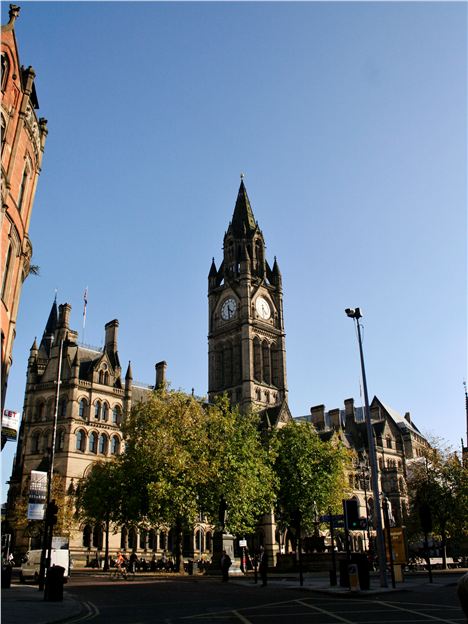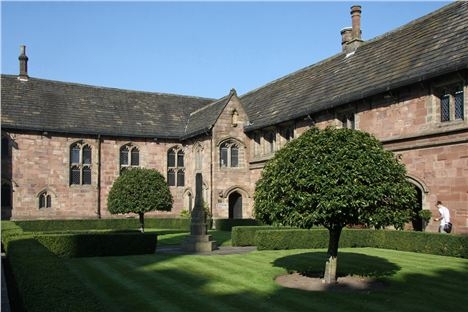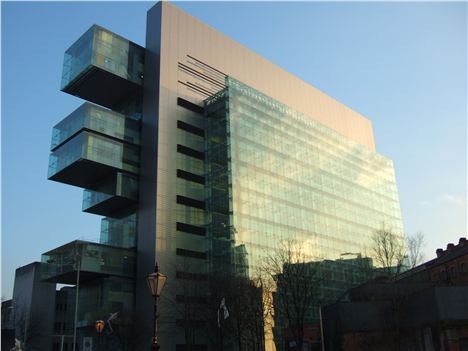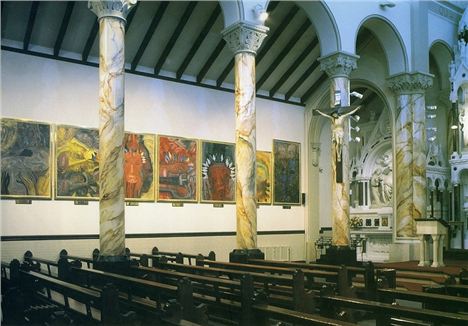THESE are the best buildings, mainly public, in the city centre, that both visitors and locals can view inside and out.
The last clause of the sentence above is important because much as I want to include representatives of Manchester's post-war twentieth century modernism, such as the CIS Tower, the public can't tour or even enter these without prior permission.
This list also does not include art galleries and museums - we'll do them at a later date.
If you have time visit all these buildings, perhaps in this order: Town Hall first and then any of Manchester Cathedral, Chetham's Library, John Rylands Library, Central Library and the Royal Exchange.
Then it would be the Civil Justice Centre or the Portico Library. Then St Ann's and St Mary's churches and the Bridgewater Hall.
This is the order used below.
Central Library would also be included here but is presently being refurbished.
You can follow Jonathan Schofield on Twitter here @JonathSchofield
Manchester Town Hall
Free to visit closes at 5pm Mon-Fri. Regular guided tours on weekends and during the week.
Completed in 1877, this Alfred Waterhouse designed building is also Manchester’s greatest monument. Internationally it is known as the Victorian building par excellence – the whole age summed up in one: the extravagance, the energy, the self-belief and the achievement. From the day it opened Mancunians knew they’d cracked it. John Bright on the opening night, described it as ‘a municipal palace. There is nothing like it in any part of the United Kingdom and in any of the great famous old cities of the Continent of Europe’. Now tagged a ‘Classic of its Age’, the building is a Gothic fantasy of finials, spires, tracery and pointed arches where High Victorian sculpture, painting and decoration reach their peak, but it’s also an extremely practical building perfect for its role as the civic centre for the city. Look out for fascinating detail and charming internal views. If accessible visit The Great Hall, The Banqueting Room and The Conference Hall. The Great Hall contains Pre-Raphaelite artist Ford Madox Brown’s series of superb murals on the history of Manchester.
Albert Square, City centre, M60 2LA. 0161 234 5000. Website
Manchester Cathedral
Free to visit daily from 8.30am. Guided tours available of the building.
The Cathedral is a pure joy. The present building is a work-in-progress spanning some 600 years full of exquisite detail and magic in the dust motes . There is a complicated dedication to St Mary the Virgin, St Denys and St George. St Denys is the patron saint of France and is included because, according to one story, Henry V wanted his claim to the French throne recognized in the charter for the new church. The style of the Cathedral is Perpendicular, unique to England, notable for strong vertical lines in windows and piers. The late medieval woodwork is some of best in the UK. The choir is especially notable with a screen and delightful stalls, or seats. These are surmounted by superbly carved canopies: each an elegant mass of spires and crochets resembling a series of perfect churches, like a late medieval imagining of a new Jerusalem. There is symbolism everywhere. Under the main seats are the misericords. The carvings under these carry an impish sense of humour not often associated with the times. In December 1940, the Cathedral suffered a direct hit during the Manchester Blitz. The post-WWII stained glass from Tony Holloway and Margeret Traherne represents the best of the new decoration in the Cathedral. The singing of the choir at evensong might make you cry: very moving. There are lots of other events too.
Victoria Street, City centre, M3 1SX. 0161 833 2220. Website
Chetham’s Library
Chetham's Library is free to visit and is open Mon-Fri, 9am-12.30pm and 1.30pm-4.30pm. The librarians are very helpful.
Chetham’s Library - and the School of Music linked to it - form the oldest complete structure in the city, dating from the 1420s, when both were erected as a single building to house clergy. After the Reformation, the premises gained a new lease of life when they were purchased through the will of local merchant Humphrey Chetham in 1653. He wished to set up a charity school for 40 poor boys and a free public library for the ‘use of scholars and others well-affected’. Only the library has daily public access. The buildings not only look ancient but feel ancient. You will have to press the bell on the library door to call an attendant. Most of the library fixtures and fittings are original and date from the mid-1600s. The books are shielded behind 18th century gates and were formerly chained to the shelves. Down the side corridor is the main Reading Room with its wonderful carvings. The collection is beautiful and the role call of visitors amazing; Daniel Defoe, Benjamin Franklin, Benjamin Disreali, Winston Churchill. Friedrich Engels and Karl Marx studied together at the bay window in the reading room. This is Manchester’s most charming building.
Long Millgate, City Centre, M3 1SB. 0161 834 7961. Website
John Rylands Library
Free to visit from Sun-Mon noon-5pm, Tues-Sat 10am-5pm. Guided tours available of the building.
If you are going to build a tribute to a loved one and you have a some spare cash, you might as well do it properly. Enriqueta Rylands had the money – millions of pounds – and the memorial she built to her dead husband, textile magnate John Rylands, is Manchester’s version of the Taj Mahal. Opened on New Year’s Day 1900, it is not only one of the city’s most beautiful buildings, but also contains one of the greatest collections of manuscripts and printed materials anywhere. The building was designed by Basil Champneys to combine the atmosphere of a monastic library with modern amenities. Inside, the place is one dramatic space after another, the stairs, the reading room. This is the last great flowering of British neo-Gothic. The best thing for a visitor to do is get lost in it - beware the ladies toilet in the old part, it’s haunted. The collections include the oldest fragment of the New Testament, a first edition of Shakespeare’s sonnets, most of the Caxtons ever printed, Guttenberg Bibles and medieval illuminated manuscripts. In the Oriental section alone there are 20,000 manuscripts in 40 different languages. Similarly the Aramaic section is one of the most acclaimed in Europe. The modern extension by Austin, Smith, Lord is rewarding too.
150 Deansgate, City centre, M3 3EH. 0161 306 0555. Website
Central Library
Free to visit Mon–Thurs 9am-8pm, Fri-Sat 9am-5pm. Closed (why?) on Sunday.
'Knowledge is power' was the slogan of Central Library when it opened in 1934: a permanently incontrovertible statement but one perhaps you wouldn't associate with a public building. But then this was always a library and then some. Designed by Vincent Harris, the circular design was said to be inspired by the Pantheon in Rome. The two grandest spaces are the entrance hall, called the Shakespeare Hall, and the Reading Room. The former has a fine stained-glass window dedicated to William Shakespeare. The main reading room on the first floor is round, dominated by the baldicchino motif of the clock balanced above the central desk. It's jaw dropping stuff deliberately...and now it's been improved. The extensive refurbishment by Ryder Architects has lightened, lifted and calmed an interior that had become cluttered since first designed by E Vincent Harris. With a superb archives centre, spectacular circulation systems including a superb new grand staircase and lift system (can people remember how bad the previous lift was?) the whole building encapsulates civic pride. The special collection is good as well with the oldest work a handwritten, 13th century copy of the Codex Justinianus, a code of law compiled for the Roman Emperor Justinian. St Peters Square, City centre, M2 5PD. 0161 234 1983 Website
'Knowledge is power' but grand scale helps too
The Royal Exchange
Free to visit Mon–Sun 10am until late in evening. Limited entry from St Ann’s Square during theatrical performances.
The principal feature, lies up the grand staircases on either side of the building. Here, under three huge domes of coloured glass and supported on massive Corinthian columns, lies the biggest room in the north of England, formerly the main trading room of the global cotton industry. For a time at the end of the 19th century and the beginning of the 20th century, the Royal Exchange controlled over 80% of the world trade in finished cloth. It is a symbol of the dramatic rise of cotton in Manchester and its equally dramatic fall. After damage during the Second World War, the building was reduced in size but the cotton industry faced with competition from countries with cheaper labour costs was doomed. The doors closed on 31 December 1968 and 249 years of history closed with them. Gloriously the building was reborn with the introduction in 1976 of the theatre. The design is a bold response to the potentially overwhelming space around it. High-tech and powerful, supported from the pillars on the sides, it nestles like a lunar module under the great dome and is the work of Richard Negri with Levitt Bernstein Associates. The bombs returned with the IRA attack in June 1996. Two years and £30m later, the building re-opened after repairs and improvements.
St Ann’s Square, City centre, M2 7DH. Entrances on Cross Street and St Ann’s Square, City centre. Website
The Civil Justice Centre
Ground floor public area free to visit weekdays during working hours. There are security checks to gain entrance.
Which of the new Manchester buildings delivers the killer visual punch? Probably The Civil Justice Centre. Australian architects Denton Corker Marshall have given the city a building that is bold in form and striking in silhouette. Standing just off Bridge Street and set back from the river, it gives the west of the city centre huge architectural excitement. Huge is the right word. This is a monster structure, 81m (266ft) tall on 15 levels over 34,000 sq m with 47 courtrooms (Technical, Family, County, Civil and High), 4 tribunal courts, 75 consultation rooms plus office and support space. It’s the biggest court complex to be built in the UK since 1882 and the Royal Courts of Justice in London. The most eye-catching parts externally are the protruding glass rooms floating one over the other, but even more the huge glass wall on the west. This is almost a canvas for the performance of the heavens - reflecting the city back on itself. The jaw-dropping moment is gained on entry looking up through the building.
1 Bridge Street West, City centre, M60 9DJ. 0161 240 5000
Portico Library and Gallery
Free to visit, Mon-Fri 9.30am-4.30pm; Sun (third every month) 1pm-4pm.
The Portico Library is bathed in the afterglow of the Age of Enlightenment. It was completed in 1806 in the Grecian style to the designs of Thomas Harrison. Built and stocked through private subscription, it originally comprised a library and a newsroom. The Portico remains perhaps the oldest subscription library in the UK. Early members included John Edward Taylor, founder of The Manchester Guardian, the scientist John Dalton and William Gaskell, chairman of the library and husband of Elizabeth Gaskell, one of the most famous 19th century novelists. Elizabeth was a frequent user and was accompanied on occasion by her friend Charlotte Brontë. A more recent member was Eric Cantona, the Manchester United and France footballer. The reading room is a lovely space with a sweet saucer dome and an original wind dial by the still surviving Thwaites of London, who would later make the clock for Big Ben. The reading room holds art exhibitions, for local and national artists, and book-related exhibitions. The first secretary was Peter Mark Roget and it is here where he started to compile his famous Thesaurus.
57 Mosley Street, entrance from Charlotte Street, City centre. 0161 236 6785. Website
St Ann’s Church
Free to visit daily 9.45am-4.45pm
St Ann’s Church is a handsome, Classically inspired building consecrated in 1712. The interior is as cool as the exterior is elegant, with galleries squatting on chubby Tuscan columns. There is some fabulously over-wrought 19th century stained glass from artist Frederick Shields - look for the sinister and tiny devilish wolf in the central window. The church is built from the local pinkish red sandstone, a material that crumbled badly under the pollution of the early industrial age, hence its rarity in the buildings of the city centre. The exterior has recently been splendidly restored. The dedication refers to the saint, of course, but perhaps more so to the lady who provided the money, Lady Ann Bland. Out of the 19 city churches built in the 18th century, St Ann’s is the only survivor. The church tower is the traditional centre of the city. On the left near the tower door is the arrow-like surveyor's mark signifying this. The church puts on frequent lunchtime events.
St Anns Street, City centre, M2 7LF. 0161 834 1161. Website
St Mary’s Roman Catholic Church
Free to visit daily from 9am-5.30pm
The earlier church on this site from 1794 was the first purpose-built Catholic church in England since the Reformation. The present building dates from 1848 by Weightman and Hadfield. This is sign-posted all around the city as The Hidden Gem – christened thus by a visiting bishop. Not all have agreed. The noted architect Pugin, in petulant mood, said the building “shows to what depth of error even good men fall when they go whoring after strange styles”. Miaow! The ornate interior has become even more eye-opening with the addition of Norman Adams’ Stations of the Cross. These are graphic, full of energy and contrast violently with the C19 interior.
Mulberry Street, City centre, M2 6LN. 0161 834 3547. Website
The Bridgewater Hall
Free to visit from 10am every day, except Sunday
The Bridgewater Hall looks best when illuminated through its levels during evening performances. High in the transparent prow, people move between the bars or stand chatting or leaning on the window rails, staring at you staring at them. The Hall opened in September 1996 and is the home to the Hallé Orchestra. It is the work of Nicholas Thompson working for RHWL. The building is stratified in almost geological layers. Taken from the canal arm, red sandstone rises from the water through limestone, metal and glass to a steel crown. A mixture of moods was required, thus after the drama of the great glass prow, you enter a cool, gentle interior. In the main entrance area, the visitor should walk straight to the reception desk then turn and look up. Above rises the inclined plane of the auditorium wall soaring back over the viewer. On the surface, Derryk Healey has applied a flowing artwork that is intended to resemble the warp threads on a giant loom. The auditorium, the sacred centre, is entered through heavy, bronze, temple-like doorways. The design of the room is a cross between the traditional shoe-box style of the older concert halls and the more modern vineyard technique where the seats fall in receding terraces.
Lower Mosley Street, City centre, M2 3WS. 0161 907 9000. Website
























